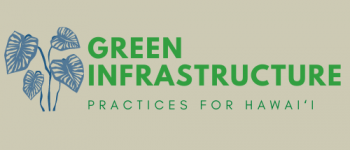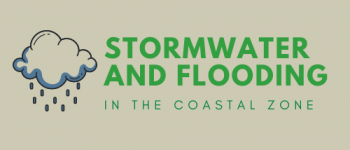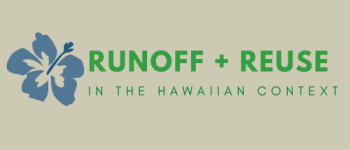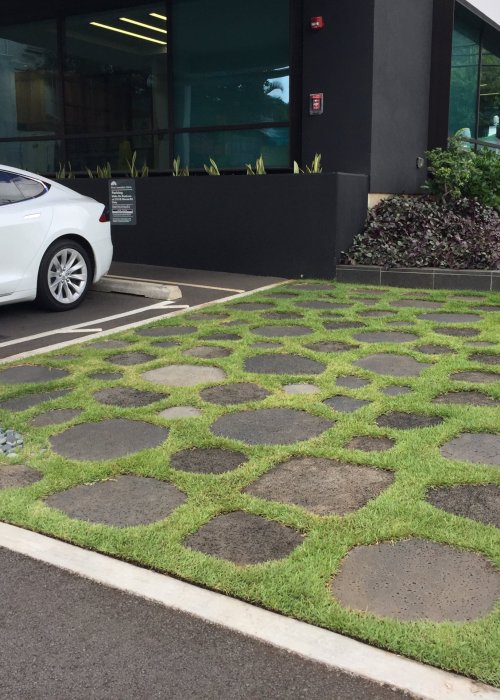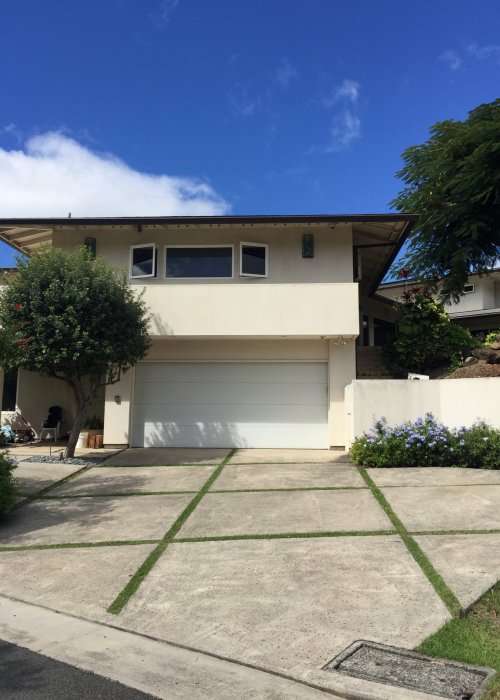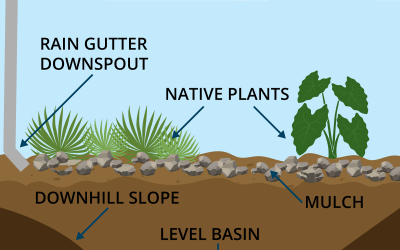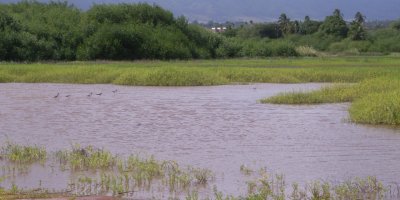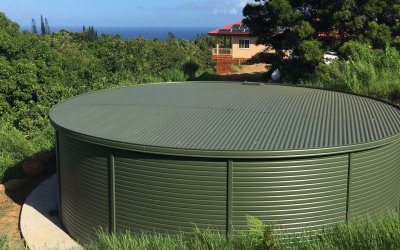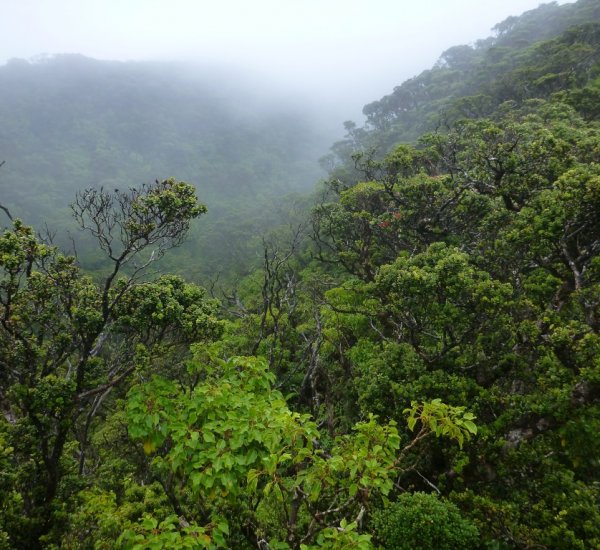Green Infrastructure Practices for Hawaiʻi
PRACTICE SUMMARY
Permeable surfaces reduce runoff volumes and pollutant loads by allowing stormwater to infiltrate into the ground and through pavement, rather than flowing across it. These surfaces are particularly cost effective in flood-prone areas with low load bearing criteria, such as parking lots, driveways, bike lanes, patios, low-use roads and sidewalks.
PRIMARY FUNCTION
Infiltration
LOCAL CONSIDERATIONS
Grade. Permeable surfaces are suitable in areas with shallow slopes.
Accessibility. Only certain types of permeable surfaces are Americans with Disabilities Act (ADA) compliant.
Maintenance Requirements. Periodic vacuum-sweeping is required to remove accumulated sediment and increase surface infiltration.
Image Gallery: Permeable driveways and paths in residential, commercial, and university areas. Honolulu, Hawaii.
PRACTICE SUMMARY
Bioretention areas are landscaping features designed to collect and treat stormwater runoff. These features come in various forms, including rain gardens and bioswales. Bioretention areas should be placed in natural or deliberately built depressions where stormwater drains and collects.
PRIMARY FUNCTION(S)
Detention, Infiltration, Treatment, and Evapotranspiration
LOCAL CONSIDERATIONS
Slope. This solution is not appropriate for mauka properties with significant slope, unless terracing is employed.
Microclimate. Landscaped bioretention areas are likely to require irrigation in leeward areas, particularly during the dry season (April-October).
Stable Soil. Yard areas draining into bioretention depressions should not flow over significant sources of soil erosion (i.e. slopes with bare clay or soil).
RESOURCES
Hawai’i Rain Garden Manual, Hui o Ko‘olaupoko
PRACTICE SUMMARY
Wetland conservation, enhancement, restoration, creation, and traditional wetland cultivation are all forms of green infrastructure. Wetlands are critical ecosystems that provide robust stormwater mitigation co-benefits by collecting and slowing down water as it travels from land to sea. While moving through wetlands, water is filtered by plants like rushes and sedges and sediments can settle out of solution before entering the nearshore environment.
Loʻi kalo are ponds used for wetland kalo (taro) cultivation. Ditches called ʻauwai are used to connect the loʻi to a nearby stream. The water from the diverted stream enters the loʻi at its uppermost inlet then flows through terraces until it is finally discharged back into the stream. Loʻi kalo and ʻauwai are important to traditional Hawaiian agriculture and watershed management.
PRIMARY FUNCTIONS
Detention and Evapotranspiration
LOCAL CONSIDERATIONS
Climate Adaptation. As sea levels rise, the inundation of historic wetlands and marshes may allow for wetland creation and restoration.
RESOURCES
Floating Treatment Wetlands to Filter Stormwater Runoff and Reduce Water Pollution, Coral Reef Alliance
Ecological Engineering, Roth Ecological Design International
Wetlands Restoration in a Hawaiian Cultural Context, Maui Coastal Land Trust
PRACTICE SUMMARY
Rainwater harvesting is a means of collecting rainwater that falls on your property. ‘Catchment’ systems like rain barrels and cisterns can be used to gather and store water that falls on your rooftop, which can then be applied as needed for non-potable uses such as gardening and toilet flushing.
PRIMARY FUNCTION
Capture
LOCAL CONSIDERATIONS
Maintenance Requirements. Gutters and downspouts are the conduits of water from the roof to your rainwater harvesting system, so be sure to keep them free and clean. Check for blockages after heavy rainstorms.
Pests. Maintain the seal of your rain barrel or cistern to eliminate mosquito breeding.
Safety. Keep keiki and pets away from rainwater harvesting devices.
RESOURCES
PRACTICE SUMMARY
Urban trees form a green infrastructure network in developed areas. The stormwater-specific benefits of tree canopy coverage include rainfall interception, increased infiltration into the ground, reduced soil erosion, and water quality improvements. Honolulu lost nearly 5% of its urban tree canopy (~76,600 trees) between 2010 and 2013, a substantial decline in natural stormwater management capability.
PRIMARY FUNCTION
Erosion Control, Filtration, Infiltration, Evapotranspiration
LOCAL CONSIDERATIONS
Maintenance Requirements. An arborist can advise on how to appropriately prune trees to reduce risk to your home during the hurricane season (June 1-November 30).
Species Selection. It is critical to avoid invasive tree species like albizia and strawberry guava, which harm native ecosystems.
RESOURCES
Urban Tree Plan, City and County of Honolulu Department of Parks and Recreation
Landowner Assistance Programs, Department of Land and Natural Resources Division of Forestry and Wildlife
PRACTICE SUMMARY
Green roofs are a type of garden designed for roof top installation. The key components of a green roof include drought resistant plants, a waterproof layer, a drainage layer, a filter membrane, a growing medium, and a vegetative layer. There are two types of green roofs, extensive and intensive. Extensive roofs use plants with shallow roots that only require a growing medium of less than 6 inches deep. Intensive roofs use growing mediums that are greater than 6 inches thick and are ideal for deep rooting plants such as trees.
PRIMARY FUNCTION
Evapotranspiration
LOCAL CONSIDERATIONS
Cost. Green roofs require high up-front costs and may increase the weight-bearing load of a structure substantially.
Maintenance. During the dry season (March-October) green roofs require irrigation.
RESOURCES
Potential for Green Roofs in Hawaiʻi, College of Tropical Agriculture and Human Resources at the University of Hawaiʻi at Manoa
PRACTICE SUMMARY
Planters are a form of green infrastructure that can enhance streetscapes and maximize the benefits gained from small spaces. Parking lots, curbs, right-of-ways, and other ‘dead’ or underutilized space can be transformed into aesthetically pleasing multifunctional areas that support for vehicular travel and the control of stormwater runoff. Flow-through planters have vertical walls and allow stormwater to be absorbed into the ground.
PRIMARY FUNCTIONS
Flow reduction, Treatment
LOCAL CONSIDERATIONS
Pollution Control. Street side green infrastructure requires consistent maintenance to control dumping and litter.


